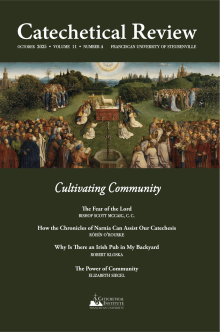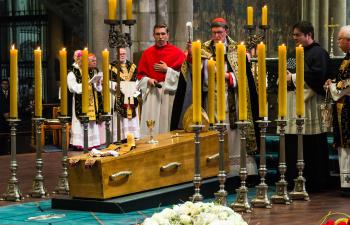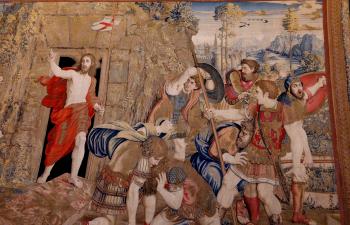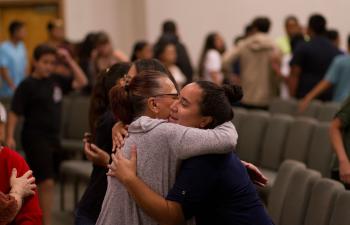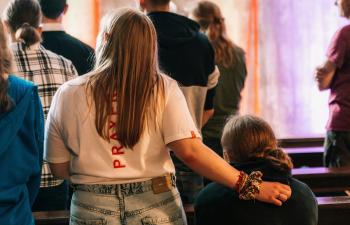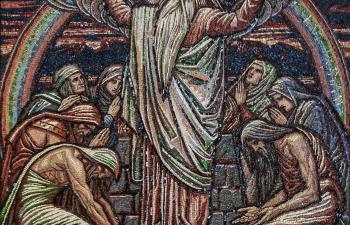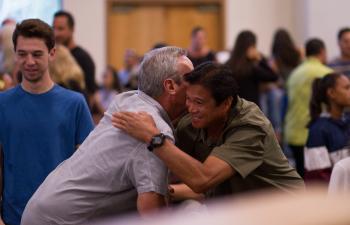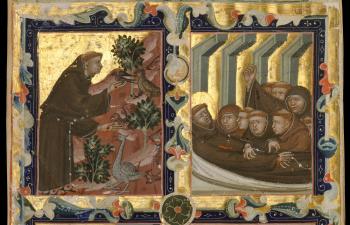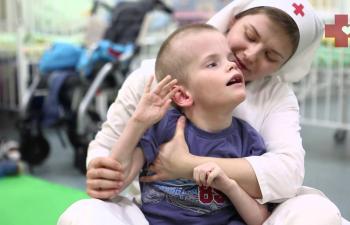 My beautiful mother, Kathleen Pauley, died on June 4, 2025 at the age of 83. She is an extraordinary person and an intimate friend of Jesus. She lived with suffering from a very early age and was well acquainted with the Cross. In the weeks of serious illness that led up to her death, I learned many things from her about our life in Christ, lessons which have helped me see suffering and death in a way more aligned with our Christian hope.
My beautiful mother, Kathleen Pauley, died on June 4, 2025 at the age of 83. She is an extraordinary person and an intimate friend of Jesus. She lived with suffering from a very early age and was well acquainted with the Cross. In the weeks of serious illness that led up to her death, I learned many things from her about our life in Christ, lessons which have helped me see suffering and death in a way more aligned with our Christian hope.
First, some background: Kathy was a woman after the Lord’s heart. Around four decades ago, she told me of being asked by our Lord in prayer if she would suffer for souls. She gave her assent to this seemingly strange request. Days later, she slipped on a puddle of water in the produce department of the grocery store and severely injured her back. And from that day on, she experienced a series of serious physical setbacks that lasted the rest of her life. Although her suffering had begun much earlier through a very difficult and painful childhood, this choice she was given by our Lord was a pivotal moment in her life where he made a proposal of love and she freely accepted it. After decades of intentionally sharing in his Cross, the final stage of her earthly pilgrimage took place over two months as she battled a very serious blood infection in her heart. This infection caused a heart attack and several strokes, which impaired her vision by about 80%. In being a member of her family who sought to accompany her through this experience, she taught me much from her school of suffering. Here are seven lessons I learned from her.
Lesson One: Suffering That Stays
My mother understood something remarkable about God: out of love, he only infrequently chooses to take away suffering. This is counterintuitive, of course, for us humans, who see suffering as the greatest of evils—as something from which we want God to rescue us. Instead, he chooses to enter deeply and intimately into our experience of suffering, accompanying us in radical, divine solidarity. Kathy experienced the presence of God in her suffering quite profoundly; she spoke sometimes of her experience of being deeply loved by Jesus as she suffered. It seems that this confidence in his closeness allowed her to embrace reality as it confronted her. Often, of course, she didn’t feel close to him; yet, she persevered in those periods of dryness and spiritual darkness. But always he provided for her, usually in unexpected ways.
Here’s a compelling example I witnessed: In her last days, I found myself marveling at how the Lord had drawn close and was uniquely providing for the needs of his beloved daughter as she suffered. Because of the strokes she had had, she often hallucinated. Yet, most of her hallucinations were of the loveliest type. For a span of about a week, she frequently believed she was not in a hospital bed facing a dire prognosis but rather at an enormous party with all of her family and friends around her. As I sat by her bedside, she asked me time and again if people were having a good time. And at one point, she brought a rush of tears to my eyes when she told me she was so excited because my daughters and nieces were going to “put on a show” for everyone, drawing on memories of a dozen years ago when the then-toddling Pauley girls loved to put on shows for Nana and Papa with play acting and singing.
Through these experiences with her, I found myself marveling at how the Lord was taking good care of his beloved and giving her joy. For much of my time with her, she was, as they say, happy as a clam. I know this isn’t the experience of most who suffer—and it certainly wasn’t her experience through most of her own life as she struggled to embrace some difficult realities. But, for a few days during her final weeks, her experience of joy showed me God’s great tenderness and closeness to her. I was so grateful to him for this. While he rarely took away her suffering, it did bring about opportunities for intimacy and union with Jesus that were just breathtaking to behold.
Lesson Two: Suffering and Self-Gift
The New Testament tells us that “God is love” (1 Jn 4:16). This means that God is “an eternal exchange of love”, with each of the persons of the Blessed Trinity making the most profound gift of self to the others (CCC 221). And if we are going to find our home in him, suffering can teach us how to pour ourselves out as a gift to him and to others. My mother ended one of those hallucinations she was having by saying, “James, I’m so tired. I just don’t think I have the energy to do all the dishes after the party.” It was a moment where her heart was again revealed to me: not only her love for communion with others but also her ingrained virtues in desiring to serve others. My mom was the kind of woman who made homemade breads and jams for teachers, the mail carrier, and new neighbors. She was a generous catechist. She was profoundly empathetic to others in their travails. Even now, at the end of her life, when the hospital personnel would bring her a meal, she was reluctant to eat in front of us and would ask if we would like to eat first.
She loved lavishly, holding very little back. So much of this propensity in her was a fruit of the sacramental grace in which she swam throughout her life—and she knew how to freely cooperate with this grace so that she became the kind of person who sought to serve up until the very final days of her life, even immobilized as she was in a hospital bed. Those earlier words from the Catechism end quite hopefully for all of us; they proclaim who God is, but they also announce the divine life to which we are called: “God himself is an eternal exchange of love, Father, Son, and Holy Spirit and he has destined us to share in that exchange.”
Always, the grace of God will move us to self-sacrificial love, especially in our experiences of suffering. Kathy loved deeply because she suffered much and didn’t allow that suffering to turn her in on herself. Rather, she showed me the importance of all the opportunities for small acts of love and service throughout one’s life, for what we have done throughout life becomes an ingrained habit in our final days and minutes. What better disposition could we cultivate within ourselves in anticipation of meeting our Lord at the end of days? And for her, suffering was integral to forming this disposition.
Lesson Three: Sacrificial Suffering
Suffering becomes sacrificial when it is offered with purpose. Through all the days of her suffering, my mom understood that she was being entrusted with a mission. We Catholics believe that the acceptance and offering of suffering can become a catalyst of grace in the world when joined to the Cross of Jesus. And so she suffered and offered, having confidence that God was doing tremendous work through her self-gift.
And she offered her suffering for so many people: her family, of course, but for so many others. She was my most powerful prayer warrior, and I would frequently ask her to pray for my wife, my daughters, my friends, my students, and those who have died. She took this work upon herself in a purposeful way. But always she strove to be in the posture of accepting and then offering to God what she suffered. I frequently told her that she will find out one day, on the other side of the veil, all of the good that she has accomplished through the offering of her suffering. I pray that in God’s mercy she might be seeing this now.
Lesson Four: Accompaniment and Offering
In those days that I sat at her bedside, I learned that she was not the only one called to offer her suffering. I found myself discovering in this experience how the Blessed Mother at the foot of her Son’s Cross wasn’t merely anguished and overwhelmed by watching her son “suffer death” (as we profess in the Nicene Creed). She also took upon herself this graced posture of accepting and then offering the sacrifice of her son as a gift to the Father. This posture ultimately required her to let him go. I took great consolation in this imagery as I sat by my mom’s bedside, offering her suffering with her to the Father.
Now that she’s died, as I’ve been dealing with the waves of grief, I am seeing that, rather than grasping for her, my offering of my mom to our Heavenly Father means to let her go into his arms, to offer her now freely to God. While she is the mother of my brothers and I—and my dad’s wife, my daughters’ grandmother, and friend to so many—she never completely belonged to us. She is first a beloved daughter of the Father and belongs to him. Turning now to this posture of offering is very much aligned with her giving of her life to God. And both represent a harmony with the total outpouring present in the God who is self-sacrificing love personified. Jesus himself, with his last breath, spoke words of total self-offering to the Father: “Father, into your hands I commend my spirit” (Lk 23:46). These words express the dynamism of divine, self-emptying love—a dynamism we are invited to radically enter.
This posture of offering is the exact opposite of the original sin, which was a grasping. The Book of Genesis describes the original sin with these words: “The woman saw that the tree was good for food and pleasing to the eyes, and the tree was desirable for gaining wisdom. So she took some of its fruit and ate it; and she also gave some to her husband, who was with her, and he ate it” (Gn 3:6). Eve took the fruit for herself, and all subsequent sin is always a “taking” and a “grasping” as well. The way that God has wrought the salvation and healing of fallen humanity has been through an action that is the opposite of what happened in the Garden of Eden. The dynamic of divine self-offering is marvelously expressed in Paul’s Letter to the Philippians: “Have among yourselves the same attitude that is also yours in Christ Jesus, who, though he was in the form of God, did not regard equality with God something to be grasped. Rather, he emptied himself, taking the form of a slave, coming in human likeness; and found human in appearance, he humbled himself, becoming obedient to death, even death on a cross” (2:5–8).
Death is our final and most profound opportunity for self-offering. Of course, this is so not only on the part of the dying person but also for those who can offer their beloved to the Father as they grieve the loss. Coming into the free gift of self is indeed the purpose of life for which every human being has been created. Living and dying in this way aligns us with the life of the Blessed Trinity and prepares us for heaven. This is the love for which we were made.
Lesson Five: Solidarity
While words always fall short in consoling a grieving person, all that is needed is solidarity. It is difficult to imagine a world without my mom in it. It’s only now that she is gone that it is becoming apparent to me that I can’t call her and confide in her and hear her beautiful voice again. There’s just no sugarcoating the loss of her loving presence.
My brother had an interesting insight: He understood for the first time the great human value of the mourning period from older eras of history, with the stoppage of regular life and the time of collective grieving. There is so much today that distracts us out of that state. Perhaps we would be better off if we remained there, focused on the work of grieving for a short but intense period of time. A key element from the experience of previous generations, though, was that, ideally, mourners were surrounded by family and the community in their grieving. They were, at least in the best of cases, with others. My brother had the extraordinary idea that during the funeral Mass our dad could sit in the front pew surrounded by his granddaughters with us directly behind him. Taking in the sight of our dad enveloped in the love of his granddaughters was quite an amazing picture to me. There is something particularly beautiful about intergenerational solidarity in grief. What a gift we can give to others, especially in this age of isolation, when we can stand with them as they mourn.
Lesson Six: Grace and Consolation in Liturgy
The funeral liturgy offers grace for the deceased and profound consolation for those who are left behind. We understand, of course, the immense spiritual value for our beloved deceased that is contained in this Mass being celebrated and offered on their behalf. But the dynamic at the heart of the funeral Mass can also be such a consolation to the grieving. Hearing again those Scriptures that unfold for us God’s power and tenderness can fix us more firmly in Christian hope. The words of this liturgy wash over us, giving expression to our sorrow and forming within us an intense hope in the faithfulness of God.

There is also something deeply good about joining together as the Mystical Body of Christ praying God’s mercy on the faithfully departed one. Life and death are such mysteries, and even if the person who has died was clearly not a saint, it is a powerful movement to enter into the dynamism of divine love and mercy as we commend this person to God and pray for his or her soul.
Around a decade ago, my parents moved to a different state where they knew only my brother’s family. Far from other family members and their many lifelong friends, there were not a lot of people at my mother’s funeral Mass. And yet, I could sense so many family and friends praying for her from a distance. And I could also sense the multitude of the angels and the saints (who fill every church at every Mass) pressing in upon us offering the Sacrifice of the Mass for her soul.
Lesson Seven: Hallowed Ground
At the Rite of Committal and with the burial of a Christian, the very ground is hallowed. In those times of life when they lived their baptismal mission most intensely, they were a source of solace and sacredness in the world. Yet, the body itself of each of us in baptism is consecrated and becomes a temple of the Holy Spirit. And when the body is buried, the piece of earth where a Christian is laid to rest—the very ground—becomes sacred.
As we were driving to the cemetery to commit my mom’s mortal remains into the ground, I was struck by the sacredness of this place of burial. This little plot of ground will be the place where one day the most extraordinary event will happen. It will be at that little plot of land in this specific cemetery that her body will one day be raised out of the grave. By the power of our Resurrected Lord, her body will be reconstituted, her soul will be enfleshed anew in her risen body, and she will live a new life in her resurrected body for all the rest of eternity. It will be this very specific piece of ground that will witness this glorious event.
The place of burial is therefore a sacred place. Our reverence for the body leads us to see this very specific piece of earth as sacred. And down through the centuries, we Christians have adorned places of burial, knowing the sanctity of these places. In Rome, the great mother city of Catholicism, one may find ancient catacombs in which early Christian believers are still buried. I recently took a tour with my students and my daughters of the catacombs of Priscilla. Descending into the ground, it is possible to walk through the ancient tunnels where our forebears in the faith commended their beloved dead to the Father of Mercies. As I walked these underground pathways, I was deeply struck by the art with which those early Christians adorned these burial places, images that call to mind their great hope in the face of death. In one chamber, three striking images are painted on the walls and ceiling. First, an image of the peacock, which (building on old mythologies) they imagined to be the bird of heaven, with all its magnificent colors like the many gems of the heavenly Jerusalem. Second, an image of the Old Testament figures of Shadrach, Meshach, and Abednego, sentenced by a wicked king to be burned alive for refusing to bow to his image. Yet, God delivered them, and when the king looked into the furnace, he saw them walking in the flames. Finally (and for me the most poignant), an image of Jesus the Good Shepherd, who goes in search of the lost sheep. Our guide explained that this image painted in a burial site was an expression of a particular faith that Jesus goes in search of the soul of the beloved dead one, taking that soul to himself with great love and affection. I found these images profoundly stirring and beautiful in those catacombs back in February when I made this pilgrimage. And now, considering my dear mother, they speak deeply to me of the hope of the Christian amidst great sorrow.
Final Thoughts
 As we are forming people in a Catholic way of seeing and living, especially when we accompany them through the loss of a loved one, we are aware of so much depth and mystery present in the experiences of suffering and death. Not only does God allow suffering, but he wishes to enter deeply with us into the midst of it so that he can be present to us in it and, one day, bring us into his victory over death. For we who grieve, he may be found right in the midst of our grief, if we understand this about him and align our hearts to his. Jesus himself wept when told of the death of his friend Lazarus (Jn 11:35), and his spirit was “deeply troubled” by death and grief (Jn 11:33), as are our spirits. And, of course, he himself went before us in the very experience of “suffering death,” making of it a door into eternal life.
As we are forming people in a Catholic way of seeing and living, especially when we accompany them through the loss of a loved one, we are aware of so much depth and mystery present in the experiences of suffering and death. Not only does God allow suffering, but he wishes to enter deeply with us into the midst of it so that he can be present to us in it and, one day, bring us into his victory over death. For we who grieve, he may be found right in the midst of our grief, if we understand this about him and align our hearts to his. Jesus himself wept when told of the death of his friend Lazarus (Jn 11:35), and his spirit was “deeply troubled” by death and grief (Jn 11:33), as are our spirits. And, of course, he himself went before us in the very experience of “suffering death,” making of it a door into eternal life.
And so, when we experience the death of a loved one, we can be confident that he has drawn particularly close to us. We can be assured that “the souls of the just are in the hand of God” (Wis 3:1), for he is “the Alpha and the Omega, the first and the last, the beginning and the end” (Rev 22:13). He is the author of life and death’s conqueror. The victory over death is his, and, joined to him as we are in his Mystical Body the Church, it will be our victory as well.
Thank you, Mom, for showing me so much about how these things are so.
Dr. James C. Pauley is Professor of Theology and Catechetics at Franciscan University of Steubenville, editor of the Catechetical Review, and son of John and Kathy.
Art Credit: Saint Veronica with the Veil, 1653, by Mattia Preti, Wikimedia Commons; Absolution of the Dead, © Raimond Spekking / CC BY-SA 4.0, Wikimedia Commons; Image of John & Kathy Pauley, by Emily Pauley.
Art Credit: Saint Veronica with the Veil, 1653, by Mattia Preti, Wikimedia Commons; Absolution of the Dead, © Raimond Spekking / CC BY-SA 4.0, Wikimedia Commons; Image of John & Kathy Pauley, by Emily Pauley.
This article originally appeared on pages 90 - 100 of the print edition.
This article is from The Catechetical Review (Online Edition ISSN 2379-6324) and may be copied for catechetical purposes only. It may not be reprinted in another published work without the permission of The Catechetical Review by contacting [email protected]



